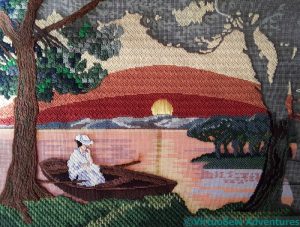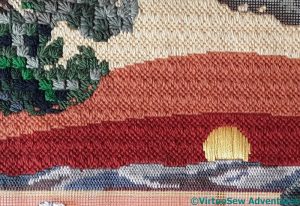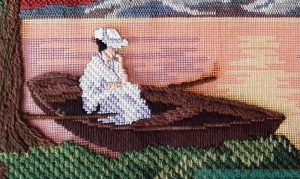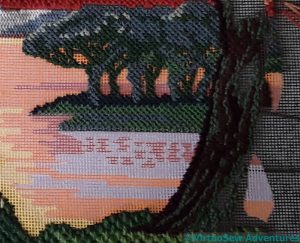Canvaswork – Sunset Study
Catherine, of Hillview Embroidery, is doing an RSN canvaswork course at the moment, and commented in a recent post that the folder of photographs of the work of past students at the back of the studio has been really useful, partly for ideas, and partly just to practice analysing designs and stitches.
I have two canvaswork pieces that use ornamental stitches to represent the textures and colours they depict, both worked when I was a teenager. It’s much easier to analyse someone else’s work than your own, so Catherine, this post (and another, as yet unwritten) is for you!
It was actually the sky that made me buy this particular painted canvas (this was long before I’d tried designing my own!). I think the stitch is Hungarian Point, and since the canvas had such a graphic feel, rather than being painterly, I was quite happy to leave the sky with those sharp colour changes. The pattern in fact runs clean through from bottom to top, but that those same colour changes mask the fact. The heather clad hills are in Plaited Stitch, worked small to help them recede. And the foliage of the tree is Ray Stitch. I do wonder whether I should have done the ray stitch facing downwards, but some of the pines have a slight upward curve, so they are staying as they are.
Almost all the threads in this piece were wool. It’s a fairly large gauge canvas, and again, there’s so much flat colour that blends wouldn’t really be suitable.
The lady in the the punt is Soft Embroidery Cotton for her skin and hair, and tubular synthetic for her gown and hat, and the punt is straight stitches in assorted browns. The tree trunk is effectively in stem stitch, and the bushes at the front are interlocking elongated cross stitches. They look surprisingly bushy, don’t they!
The trees in the distance are in Upright Cross Stitch, which makes a good intermediate texture between the bushes at the front and the distant hillside.
And that near tree? That’s one of the reasons I didn’t finish. I found that not only was I not enjoying the combination of stitches, I was running out of the threads and colours I was using. I threw it in the loft in frustration and disgust and only fished it out again after I’d read Catherine’s post.
The sea is another reason. I still haven’t worked out how to do it, and at the moment, I am still not at all sure I want to.
You can click on all the pictures to see them more closely, so Catherine, your homework is to look at them all, think about what you like and what you’d have done differently.
And if any of you have any suggestions for the sea – let me know!





This is a very pretty piece. I like the different stitches used. It really does give it dimension.
Very interesting piece with texture developed through your choice of threads and stitches.. For the water, try long horizontal stitches with cotton floss. Keep the strands used low so the canvas shows through and the floss will unite the areas of color.
I really like this! So pretty.
Thanks so much Rachel! It’s very interesting reading about it, and that I have inspired you to have another look at it. It is such a pretty design, and I really love the sky- I love that stitch used, so I may just incorporate it into my sky! It’s interesting that you don’t blend huge numbers of different threads, and yet still achieve a lovely result. Something to be learned there! I have really loved using Romanian couching for the water in my piece. It seems to really flow, and if you aren’t adverse to getting different threads, a thread with some silk in it (maybe just for the couching thread), that beautiful shimmer in the sky would really come through. Thanks so much!
I have kept away from Canvas Work, mainly I think because it cojured up images of old ladies stitching. Also, most of the work I had seen was only canvas stitch. After looking at your work I think I have done it a great disservice.
Makes me want to unpick that huge canvas work picture I did years ago and start again! But I’m not going to do that! Never go back!
I’m amazed that you did this when you were a teenager. I don’t believe I ever sat still long enough at that age. Its a beautiful piece.
How interesting to see the way you process an unfinished canvas! The difference between working on a painted canvas and designing your own– moves from stitching to creating, which involves using everything you have learned!
The upright cross areas work particularly well.
I agree with Paula about the sea areas – light, horizontal lines, with some sheen. A bit of canvas showing won’t hurt. But use more strands for path of the sunlight on the water, to bring it out clearly.
oh wow, that’s a fantastic piece! I think you should finish it off.
Silk for the sea, to give a shimmer? Love the different textures your different stitches have produced.
you have invested so much time and care into this Rachel. Do you think you will finish it at some point?
I’ve had projects like that too where I’ve done so much work on them and then get to the point where I just didn’t know how to complete the next section. I even have pieces that are finished, but I haven’t a clue what I want to turn them into and they’re just sitting in a bin, waiting for me to decide.
Thanks so much for linking up to last week’s Stitchery Link Party. Aloha hugs!
When you were a teenager??? Oh my gosh, you must have started really young to be so experienced by then. I know it would be hard to match threads now, but it’s so close to completion, it seems a shame not to finish it. I have never done that kind of stitching, so I don’t have any suggestions for the sea, but I know you will figure out something – maybe not what you would have done back then, but something that suits it and you now.
I recently finished a picture for a friend, which showed her and her rowing partner winning their event in a National Championship event on an inland lake. The boat stretched from end to end – you couldn’t see the pointy bits – so the water was effectively in two parts: near and far. I used Alternating Nobuko for both. The foreground was in a dark-blue variegated perle cotton, and the background in a lighter version. Foreground, I used Double Alternating Nobuko and where necessary (the blade of an oar, the bright jackets of the rowers) I did the two small stitches in those colours – white for the blade, turquoise and yellow for the jackets and yellow for a buoy – to look like reflections. It worked well. Then for the background water, I used Single Alternating Nobuko in the lighter blue to reflect the sky, with the same reflections trick as it got shallower near to the mud and bushes of the shoreline.
Alternating Nobuko made the water seem to move in waves and ripples!
For your foreground treetrunk, you might try Chain Stitch. Nice small loops so the canvas doesn’t show through!